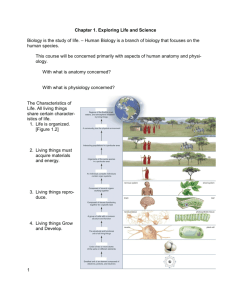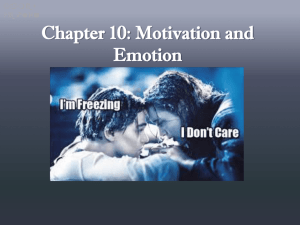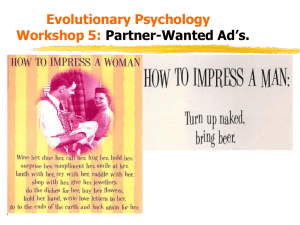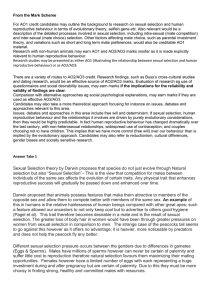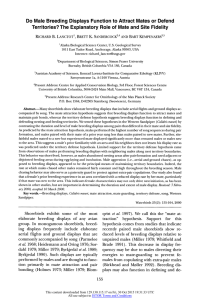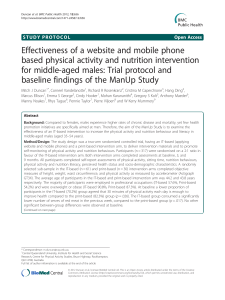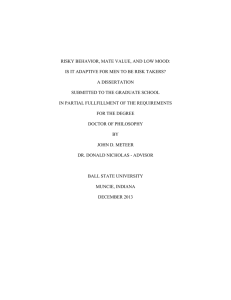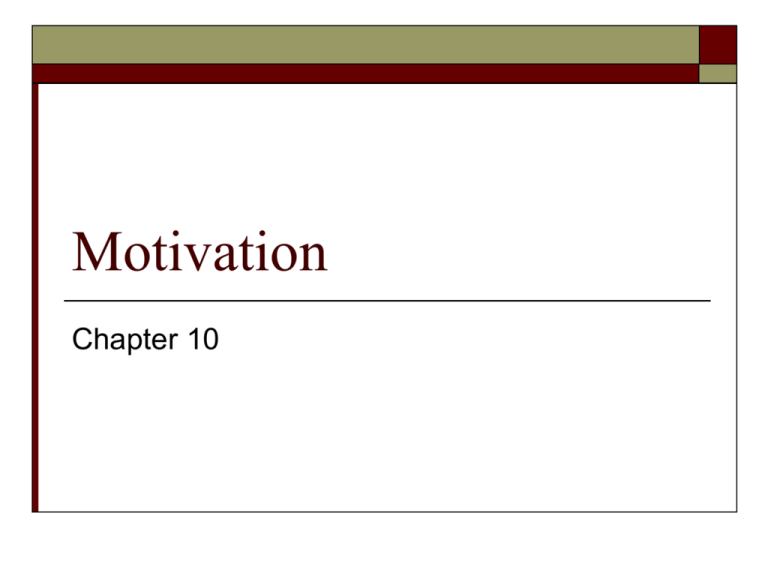
Motivation
Chapter 10
Motivational Theories and Concepts
Motives – needs, wants,
desires leading to goaldirected behavior
Drive theories – seeking
homeostasis
Incentive theories –
regulation by external
stimuli
Evolutionary theories –
maximizing reproductive
success
Diversity of motives
Biological versus Social motives
The Motivation of Hunger and Eating:
Biological Factors
Brain regulation
Glucose and digestive
regulation
Lateral and ventromedial
hypothalamus
Paraventricular nucleus
Glucostatic theory
Hormonal regulation
Insulin and leptin
The Motivation of Hunger and Eating:
Environmental Factors
Learned preferences
and habits
Food-related cues
Exposure
When, as well as what
Appearance, odor, effort
required
Stress
Link between heightened
arousal/negative emotion
and overeating
Eating and Weight: The Roots of
Obesity
Evolutionary
explanations
Genetic predisposition
Body Mass Index and
adoption study
The concept of set
point/settling point
Dietary restraint
Sexual Motivation and Behavior:
Determining Desire
Hormonal regulation
Pheromones
Synchronized menstrual
cycles
Aphrodisiacs
Erotic materials
Attraction to a Partner
Estrogens
Androgens
Testosterone
The Coolidge effect
Evolutionary factors
Gender Differences in Sexual Activity
Males show a greater interest in
sex than females.
Males have more frequent and
varied sex fantasies
Males subjective ratings of sex
drives are higher.
More motivated to pursue a
greater variety of partners
More willing to engage in
casual (uncommitted sex)
Differences may be exaggerated
because of double standard
towards sexuality
Women may downplay
sexuality to avoid be considered
permissive
20
15
Men
Women
10
5
0
m
o
6 .
m
os
.
1
yr
2 .
yr
s.
3
yr
s.
4
yr
s.
5
yr
10 s.
yr
20 s.
yr
s
30 .
yr
s.
lif
e
1
Gender Differences and Mate Preferences
Parental Investment Theory
Females look for mate that
could
Provide resources
Was willing to invest
resources
Protect family
Males look for mate that
Had good reproductive
potential
Young and healthy
Would be faithful
Nuturing
Other explanations
Expectancy Theory
Valence - attractiveness of an outcome to an individual
Instrumentality - strength of belief that
Outcomes
(e.g.,
“A” on of
test,
raise,
performance
results
inpromotions)
outcome
Expectancy
- strength
belief
that
effort attainment
will result in successful performance
MASLOW’S HIERARCHY OF NEEDS
ACTUALIZATION
ESTEEM
SOCIAL
SAFETY
PHYSIOLOGICAL
Motivation
McClelland’s Learned Needs
Need for Achievement
a need to accomplish goals, excel, and strive continually to do
things better.
Need for Affiliation
desire for friendly and close interpersonal relationships
affiliative interest
affiliative assurance
Need for Power
the need to influence and lead others and be in control of one’s
environment
socialized power
personalized power
Interpreting the TAT
Affiliation
+ emotional relationship
likes another
wants to be liked by another
affiliate activities
Achievement
standard of excellence
unique accomplishment
long-term goal
Situational Determinants of Achievement

